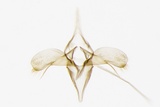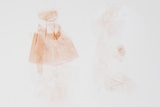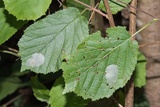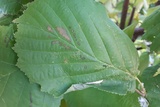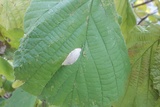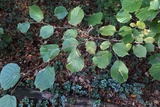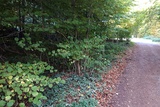Phyllonorycter coryli (Nicelli, 1851) Species
Last modified: Dec. 10, 2025, 4:45 p.m.
A widespread and very common species in Belgium.
Details
- Classification
- Family: Gracillariidae > Subfamily: Lithocolletinae > Genus: Phyllonorycter > Species: Phyllonorycter coryli
- Vernacular names
- Hazelaarblaasmot (NL), Nut-leaf blister moth (EN), Mineuse du Noisetier (FR), Haselnuss Miniermotte (DE)
- Synonyms
- Phyllonorycter corylella (Herrich-Schäffer, 1855)
- First mention in Belgium
- De Fré Ch. 1858. Catalogue des Microlépidoptères de la Belgique. — Annales de la Société entomologique belge 2: 45–162. On page 156 (as corylella). view page
- Status
-
Native
Distribution
Imago
Head mixed greyish and brown hairs; forewing ground colour brown, four white costal and three white dorsal striae.
Museum specimens
No pictures yet!Specimens in nature
No pictures yet!Caterpillar
First instars greenish white. Later instars greenish yellow with a dark brown or black spot on the dorsal side of each segment. A large blackish spot on the prothoracic segment. Head almost black.
Mine
Whitish or silvery tentiform mine on the upperside of a leaf, often with a papery appearance. Later instars cause the leaf to contract strongly, especially when more mines are present on the same leaf. When the mine is situated at the margin of a leaf, the margin can be folded over the mine, thus resembling the mine of Parornix devoniella which lives on the same host plant. The difference is that the caterpillar of Parornix devoniella attaches the folded leaf with external spin, while the contraction of the leaf in Phyllonorycter coryli is caused by spinning inside the mine. The dark frass is contained in a corner of the mine.
See also gracillariidae.net and bladmineerders.be.
Cocoon/pupa
A whitish cocoon inside the mine.
Bionomics
Sometimes several eggs are deposited on one leaf, but always on the upperside. The last instar pupates inside the cocoon within the mine. The pupa of the second generation hibernates in the mine, in fallen leaves among leaf litter on the ground. The adults rest during the daytime and come to light.
Flight periods
Two generations a year from mid-April to the beginning of June and from mid-July till September.
